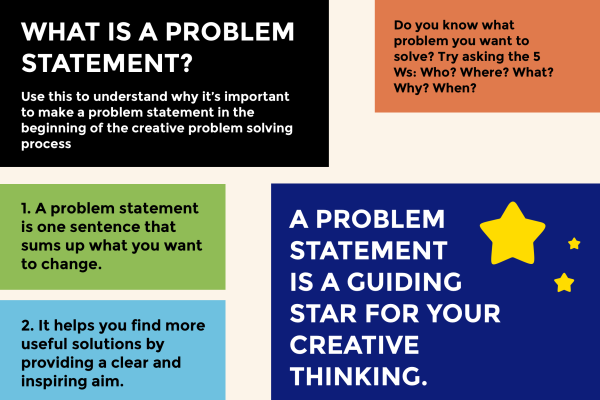
How to write a good problem statement
Francesco Marcatto26 Sep 16

The first step to solving a problem is knowing that you have it. The second step is communicating it to others. To do that you can create a ‘problem statement’, which is a great place to start a brainstorming session.
The aims of a problem statement are:
**(a) to communicate the problem to all the group members and **
(b) to help everyone in the group find good solutions
Why is a problem statement so important?
Most organisations underestimate the relevance of having a well thought out problem statement. At worst, they think it’s a waste of time. Generating ideas is more interesting and fun: “We don’t have much time, let’s just start creating ideas!”. If you’re in one of those organisations, keep reading!
Taking time to define a problem well is the best way to start a creative problem solving session on the right foot. This is especially true in a group setting, where you have to bring together people with different backgrounds and expertises. Having a clear focus stops it from being just another time wasting meeting.
What is a good problem statement?
A good problem statement is clear and actionable.
How many times has your manager or CEO started a meeting with some vague aim like ‘let's maximise shareholder value’? According to Chip and Dan Heath, authors of the amazing book on effective communication ‘Made To Stick’, this is a clear example of opaque and abstract communication. Notice the next time it happens and try to apply the principles below!
Make it clear
Clear means it’s easily understandable by all the group members. It communicates the goal. This becomes trickier the more complex the problem is, and the more diverse the expertise of the group are. It’s well worth focusing on though because you want people’s efforts to be focussed on finding good solutions, not trying to understanding the problem.
One thing to watch out for is the curse of knowledge, a cognitive bias where you unknowingly assume others in the group have the background to understand you. Try asking someone with a different background to explain the problem back to you and see where the gaps in knowledge are.
Make it actionable
To make the problem actionable, you have to define its boundaries. You have to specify the characteristics of the problem and define the space in which the solution should be found. It may seem counterintuitive, but constraints foster creativity by helping you know where to focus your energy.
How does this work in practice? Don’t expect original solutions from a generic problem statement like ‘How can we increase our sales?’. Instead, make it more specific to provide a clearer challenge to overcome, for example, ‘How might we change our shop window displays to increase our sales by 10% in the next 4 months?’.
Define the constraints
As Patricia Stokes wrote in her excellent book ‘Creativity from Constraints: The Psychology of Breakthrough’; when people are totally free to solve a problem, they naturally tend to focus on what’s worked best in the past.
Complete freedom hinders creativity, while a smart use of constraints, such as precluding the availability of some resources like materials, skills, money or time is useful in directing the search for new solutions, promoting novel and surprising responses. For example, instead of using ‘How can we increase our online sales?’, try something like ‘How can we increase our online sales, without spending money, using social networks?’.
Define the specificity
Another useful aspect, is to define from the beginning the required specificity level of the answers. For example, ‘a relaxing place’, ‘the Alps’, and ‘Chamonix, France’, are all answers to the problem question ‘Where might we go on the next family holiday?’, but they go from being very abstract (‘in a relaxing place’), to hyper-specific (‘Chamonix, France’).
Think for a moment: what are you looking for with your problem statement? Some general inspiration? A city or a geographic area? A specific resort or hotel? If you haven’t defined that, it will lead to confusion both when generating ideas (what are we looking for?) and when selecting the best idea (how can we compare ideas?).
If you are not certain of the best specificity level to use, you can work recursively: start abstract and do more sessions in which you go deeper.
Don’t give examples
You may think giving an example is best way to define the constraints and specificity but I urge you not to. The research clearly says, ‘don’t do it’. When potential options are presented as cues, option generation performance decreases significantly, an effect called ‘part-set cuing in option generation’. This seems to be due to the fact that the supplied examples work as anchors and it is difficult to move away from them and produce novel ideas.
If you’re aiming for originality, avoid examples.
A checklist when writing an effective problem statement
Do’s
- Write the problem statement as a question. The best place to start is with a ‘How might we…?’ as IDEO says, ‘How Might We questions to turn those challenges into opportunities’.
- Keep it short! Remember that people can easily forget too much information, and don’t read huge walls of text.
- Deal with only one problem at a time. If you have more problems, run more creativity sessions. Each session = one single problem.
- Define the problem’s boundaries. Instead of ‘How can we increase our sales?’, try something like ‘How can we increase our online sales by 15%?’. If you are not sure how to best describe your problem’s boundaries, first run a workshop with your group to find them.
- Define the specificity. How abstract do you want the ideas to be?
Don’ts
-
Avoid problem statements too abstract, vague or long. Remember that a good problem statement should be actionable! Be simple, concrete, and well defined.
-
Avoid jargon and cryptic language. Instead, try to understand what the knowledge of the other participants is, and adjust the message accordingly. Don’t fall prey to the curse of knowledge!
-
Constraints can promote creativity, but too many constraints can preclude creativity and problem solving. Try to find a balance between too few and too many constraints and specifications. As Marissa Ann Mayer, CEO of Yahoo!, wrote ‘Creativity thrives best when constrained. But constraints must be balanced with a healthy disregard for the impossible’.
-
Don’t give examples. They act as anchors and decrease the originality of your thinking.
These are my suggestions so far, but I’m eager to know what you have found works brilliantly for creating problem statements that boost to your creative problem solving sessions. Drop me a line at hello@mindiply.com.
Good project management starts by defining the scope of the project. If you are looking for a great way to manage online your projects and your resources, try Mindiply, our new smart project management tool. It’s based on research and you can sign up for early access here!
Updated and edited on Tuesday 15th October 2019.







